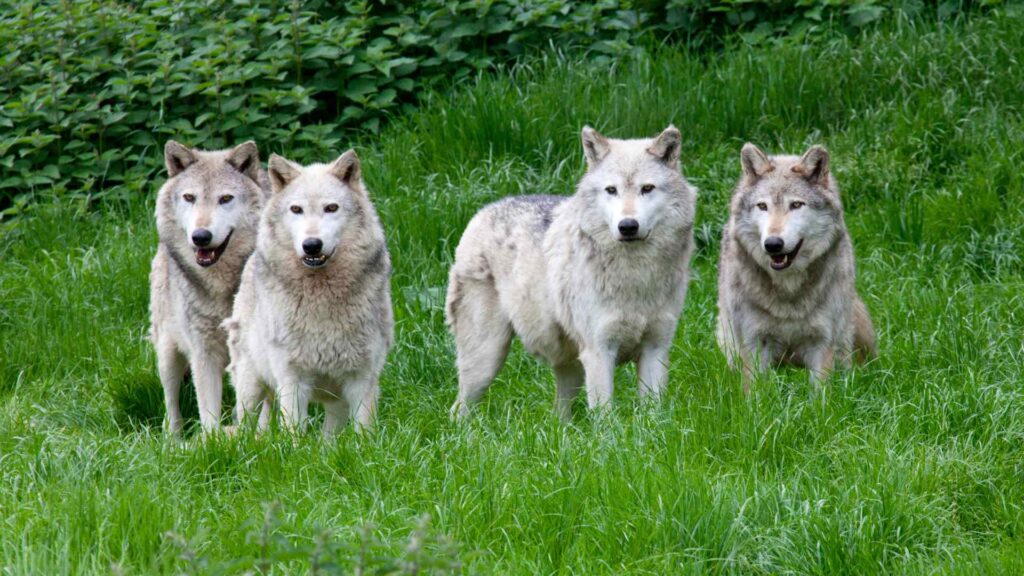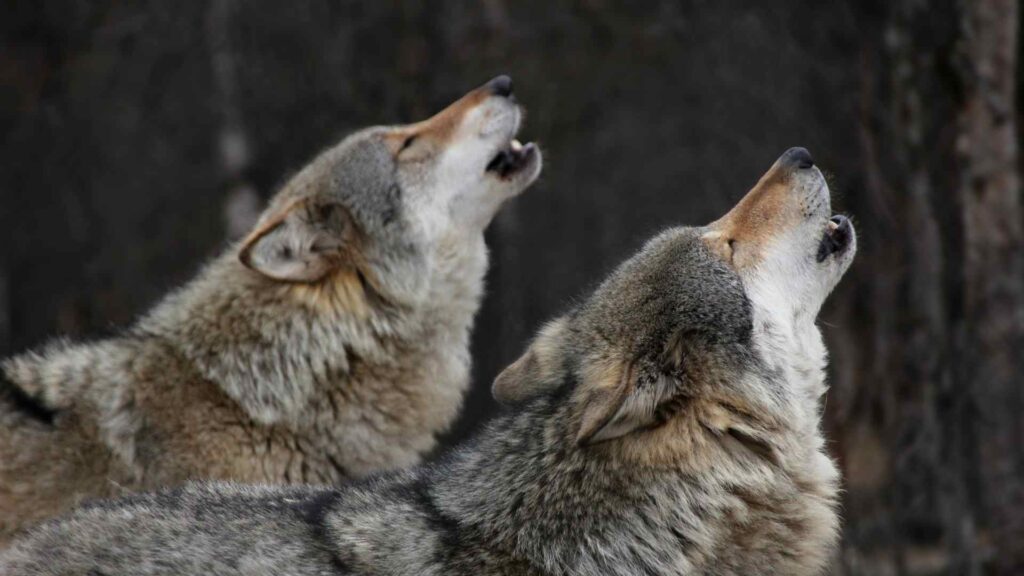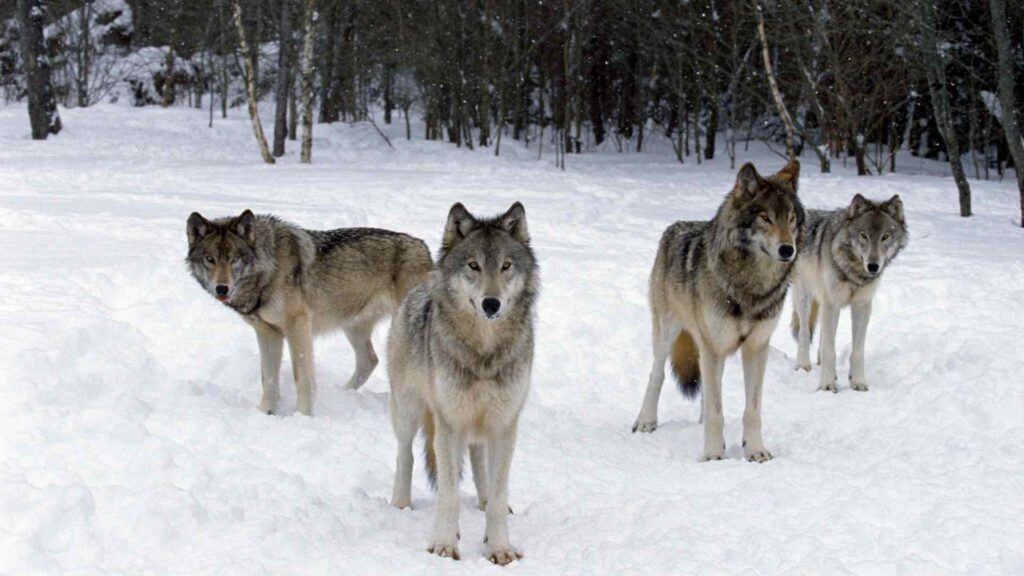Wolves are captivating creatures with extraordinary abilities, complex social structures, and intriguing habits.
Whether you’re a wildlife enthusiast or simply curious, this guide provides 145 amazing facts about wolves, meticulously categorized for your reading pleasure.
Dive in to uncover the secrets of these majestic animals!
The Mystique of Wolves
- Wolves are found across North America, Europe, Asia, and the Arctic.
- Ancient cultures revered wolves as symbols of courage and loyalty.
- A wolf’s howl can travel up to 10 miles in open terrain.
- Wolves have a unique scent that helps pack members identify each other.
- Their eyes glow in the dark due to a reflective layer called the tapetum lucidum.
- Wolves are excellent swimmers and can cross rivers over a mile wide.
- They have about 200 million scent cells, making their sense of smell 100 times better than humans.
- Wolves’ coats adapt seasonally, becoming thicker in winter.
- The earliest fossil of a wolf dates back over 800,000 years.
- Wolves can survive in temperatures as low as -40°F.
- Packs are typically family units, consisting of parents and their offspring.
- Wolves communicate through body language, facial expressions, and sounds.
- Arctic wolves rarely drink water because they derive moisture from their prey.
- The alpha pair of a wolf pack is usually the only pair to breed.
- Wolves play a vital role in maintaining the balance of ecosystems.

Wolf Anatomy and Physiology
- Wolves have 42 teeth, including powerful carnassials for slicing meat.
- Their paws are webbed, aiding them in navigating snow and mud.
- The average wolf weighs between 50–110 pounds, depending on the species.
- A wolf’s jaw exerts a bite force of around 400 pounds per square inch.
- Their fur is waterproof and helps regulate their body temperature.
- Wolves possess exceptional hearing, detecting sounds up to six miles away in the forest.
- They have two layers of fur: a dense undercoat and a weather-resistant outer coat.
- Wolves’ tails are bushy and help them maintain balance when running.
- The gray wolf is the largest species, with males growing up to 6.5 feet in length.
- They can run at speeds of up to 38 miles per hour during a chase.
- Wolves’ olfactory bulbs are about five times larger than those of domestic dogs.
- Their thick pads protect their feet from sharp rocks and ice.
- Wolves’ vision is optimized for detecting movement in low light.
- Pups are born blind and deaf, relying on their mother’s milk for nourishment.
- Wolves shed their undercoat each spring to stay cool in the warmer months.
Wolf Social Dynamics
- Packs can range from 2 to 20 members, depending on food availability.
- The hierarchy in a pack includes alphas, betas, and omegas.
- Wolves are known for their teamwork during hunts.
- Omega wolves often act as peacemakers within the pack.
- Wolves rarely fight among pack members unless the hierarchy is challenged.
- When a wolf leaves its pack, it’s called a disperser.
- Dispersers may travel hundreds of miles to find a new territory or mate.
- Wolves form lifelong bonds with their mates.
- They perform playful greetings by licking each other’s faces.
- Subordinate wolves display submission by lowering their tails and exposing their bellies.
- Pack members take turns guarding pups while others hunt.
- Wolves engage in communal howling to strengthen pack unity.
- A pack’s territory can span hundreds of square miles.
- Scent marking helps wolves delineate their territory.
- Wolves mourn the loss of a pack member, showing signs of grief.

Hunting and Feeding Habits
- Wolves primarily hunt large ungulates such as deer, elk, and moose.
- They are opportunistic predators and will eat small mammals, fish, and carrion if needed.
- Wolves eat around 10 pounds of food per day, though they can consume up to 20 pounds in a single meal.
- Their hunting strategy involves isolating the weakest or slowest member of a herd.
- Wolves can go several days without eating if prey is scarce.
- They use their powerful jaws to crush bones and access marrow.
- Wolves cache surplus food by burying it for later.
- A pack’s hunting success rate ranges from 10–30%, depending on the prey.
- Wolves use their acute senses to detect prey from miles away.
- They often rely on endurance rather than speed to tire out their prey.
- Cooperative hunting allows wolves to take down animals much larger than themselves.
- Wolves consume nearly every part of their prey, minimizing waste.
- Lone wolves are less effective hunters but can survive on smaller prey.
- Wolves will scavenge food left by other predators.
- Their strong stomach acid allows them to digest even bones.
Wolves in Mythology and Culture
- Norse mythology features Fenrir, a giant wolf destined to play a key role in Ragnarök.
- The Romulus and Remus legend credits a she-wolf with raising the founders of Rome.
- Native American tribes often view wolves as spiritual guides.
- Wolves symbolize strength and perseverance in many cultures.
- In Japanese folklore, wolves are guardians of crops and livestock.
- Medieval European folklore often depicted wolves as fearsome beasts.
- The term “lone wolf” originates from the solitary behavior of dispersers.
- Wolves are prominent in fairy tales like “Little Red Riding Hood.”
- Siberian shamans revered wolves as protectors of the underworld.
- The wolf appears in countless coats of arms and family crests.
- In Celtic mythology, wolves are associated with the moon.
- The Germanic wolf-god Woden is thought to inspire wisdom and protection.
- Wolves are commonly featured in modern literature and media, symbolizing freedom.
- Mongolian tribes regard wolves as the ancestors of their people.
- The phrase “cry wolf” comes from Aesop’s fable about lying shepherds.

Bonus Facts About Wolves
- Wolves can smell prey buried under two feet of snow.
- They rarely attack humans unless provoked or rabid.
- Wolves are excellent climbers and can navigate rocky terrain.
- The Mexican gray wolf is one of the most endangered subspecies.
- Wolves play a crucial role in keeping prey populations healthy by targeting the sick and weak.
- Their howling is often mistaken for aggression but usually signals bonding.
- Wolves have inspired conservation efforts worldwide.
- Pups begin howling as early as two weeks old.
- Wolves maintain lifelong memories of past experiences.
- Their thick fur protects them from frostbite.
- Wolves can adapt to various climates, from deserts to tundras.
- The Ethiopian wolf is Africa’s most endangered carnivore.
- Wolves use facial expressions to convey emotions within the pack.
- The average lifespan of a wolf in the wild is 6–8 years.
- Wolves have a third eyelid, or nictitating membrane, that protects their eyes.
- Their sense of touch is enhanced by sensitive whiskers around their muzzle.
- Wolves are monogamous and typically mate for life.
- Alpha wolves lead by influence and experience, not brute force.
- Wolves dig dens to protect their pups from predators and harsh weather.
- A single wolf can travel up to 30 miles in one day in search of food.
- Wolves pant to regulate their body temperature after physical exertion.
- The red wolf is a critically endangered species native to the southeastern United States.
- Wolves can detect changes in weather, such as incoming storms, through their acute senses.
- They are capable of running for hours without tiring.
- Wolves are known to play games, such as tug-of-war with sticks, to strengthen social bonds.
- Some wolf subspecies, like the Himalayan wolf, inhabit high altitudes.
- A wolf’s howl is unique, much like a human fingerprint.
- They are one of the few animals capable of altruistic behavior, helping injured pack members.
- Wolves are crepuscular, meaning they are most active during dawn and dusk.
- Fossil evidence suggests that wolves existed over 2 million years ago.
- A wolf’s brain is roughly 30% larger than that of a domestic dog.
- They prefer to avoid confrontation with other predators, like bears and cougars.
- Wolves can communicate through tail wagging and ear positioning.
- Their diets vary based on location, including anything from caribou to salmon.
- The Arctic wolf has smaller ears to conserve heat in freezing temperatures.
- Wolves shed heavily in spring, often forming thick mats of fur around their territories.
- They rely on pack cooperation to teach pups hunting techniques.
- Wolves can leap up to 12 feet in a single bound.
- Ancient humans and wolves are believed to have coexisted as hunting partners.
- Wolves’ front paws are larger than their back paws for better traction in snow.
- The gray wolf is the most widespread species of wolf.
- Wolves’ howls are rarely mistaken by pack members, even from great distances.
- Some packs develop distinctive hunting techniques suited to their environments.
- They are highly adaptable predators, capable of thriving in urban-fringe environments.
- Wolves regulate prey populations, benefiting vegetation and smaller species.
- They exhibit a phenomenon called “post-hunt euphoria,” shown through playful behavior after a successful kill.
- Wolves can identify individual human scents, distinguishing between strangers and familiar people.
- Despite their reputation, wolves are shy and avoid humans in the wild.
- The black coat color in some wolves is due to ancient interbreeding with dogs.
- Wolves play a significant role in the food chain as apex predators.
- They are known to track migrating herds for weeks before making a move.
- Wolves have excellent memory, often recalling specific locations of food caches.
- The dire wolf, a prehistoric relative, was significantly larger than today’s wolves.
- Wolves occasionally adopt lone members from other packs into their own.
- Their territories often overlap with other packs, leading to occasional confrontations.
- The social hierarchy of wolves is flexible and can change based on circumstances.
- Wolves in captivity often live longer than those in the wild, sometimes up to 16 years.
- They use vocalizations like barks and growls in addition to howls for communication.
- Wolves have been observed playing with other species, including ravens.
- They form deep emotional bonds with their pack, showing affection and loyalty through frequent interaction.
Conclusion:
Wolves are truly extraordinary creatures, embodying resilience, intelligence, and beauty.
Their fascinating traits and behaviors offer endless opportunities for learning and admiration. Whether revered in mythology or observed in the wild, wolves captivate us with their spirit and strength.
